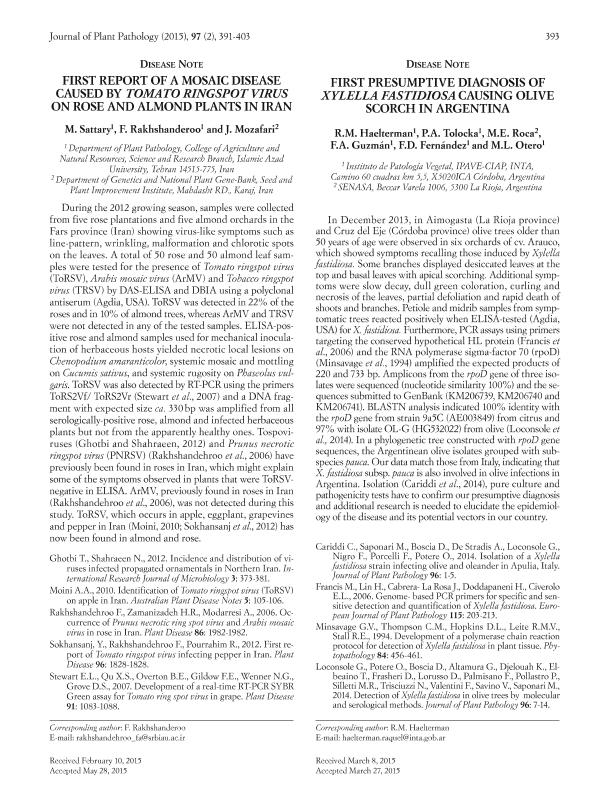Artículo
First presumptive diagnosis of Xylella fastidiosa causing olive scorch in Argentina
Haelterman, Raquel Mercedes ; Tolocka, Patricia Andrea; Roca, M. E.; Guzmán, F. A.; Fernández, F. D.; Otero, M. L.
; Tolocka, Patricia Andrea; Roca, M. E.; Guzmán, F. A.; Fernández, F. D.; Otero, M. L.
 ; Tolocka, Patricia Andrea; Roca, M. E.; Guzmán, F. A.; Fernández, F. D.; Otero, M. L.
; Tolocka, Patricia Andrea; Roca, M. E.; Guzmán, F. A.; Fernández, F. D.; Otero, M. L.
Fecha de publicación:
08/2015
Editorial:
Edizioni Ets
Revista:
Journal of Plant Pathology
ISSN:
1125-4653
Idioma:
Inglés
Tipo de recurso:
Artículo publicado
Clasificación temática:
Resumen
In December 2013, in Aimogasta (La Rioja province) and Cruz del Eje (Córdoba province) olive trees older than 50 years of age were observed in six orchards of cv. Arauco, which showed symptoms recalling those induced by Xylella fastidiosa. Some branches displayed desiccated leaves at the top and basal leaves with apical scorching. Additional symptoms were slow decay, dull green coloration, curling and necrosis of the leaves, partial defoliation and rapid death of shoots and branches. Petiole and midrib samples from symptomatic trees reacted positively when ELISA-tested (Agdia, USA) for X. fastidiosa. Furthermore, PCR assays using primers targeting the conserved hypothetical HL protein (Francis et al., 2006) and the RNA polymerase sigma-factor 70 (rpoD) (Minsavage et al., 1994) amplified the expected products of 220 and 733 bp. Amplicons from the rpoD gene of three isolates were sequenced (nucleotide similarity 100%) and the sequences submitted to GenBank (KM206739, KM206740 and KM206741). BLASTN analysis indicated 100% identity with the rpoD gene from strain 9a5C (AE003849) from citrus and 97% with isolate OL-G (HG532022) from olive (Loconsole et al., 2014). In a phylogenetic tree constructed with rpoD gene sequences, the Argentinean olive isolates grouped with subspecies pauca. Our data match those from Italy, indicating that X. fastidiosa subsp. pauca is also involved in olive infections in Argentina. Isolation (Cariddi et al., 2014), pure culture and pathogenicity tests have to confirm our presumptive diagnosis and additional research is needed to elucidate the epidemiology of the disease and its potential vectors in our country.
Palabras clave:
Bacteria
,
Xylem
Archivos asociados
Licencia
Identificadores
Colecciones
Articulos(CCT - CORDOBA)
Articulos de CTRO.CIENTIFICO TECNOL.CONICET - CORDOBA
Articulos de CTRO.CIENTIFICO TECNOL.CONICET - CORDOBA
Citación
Haelterman, Raquel Mercedes; Tolocka, Patricia Andrea; Roca, M. E.; Guzmán, F. A.; Fernández, F. D.; et al.; First presumptive diagnosis of Xylella fastidiosa causing olive scorch in Argentina; Edizioni Ets; Journal of Plant Pathology; 97; 2; 8-2015; 391-391
Compartir
Altmétricas



